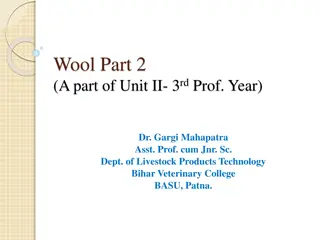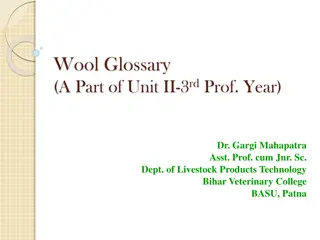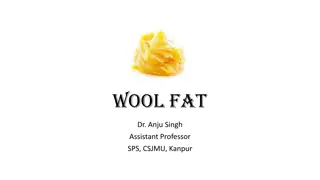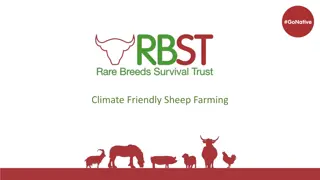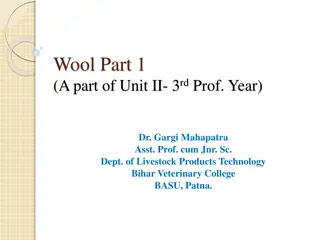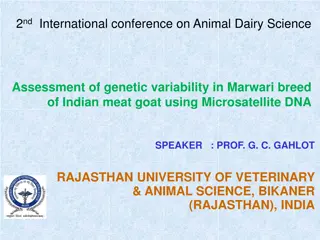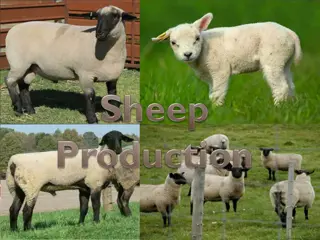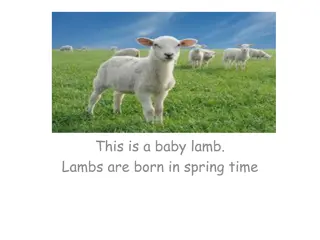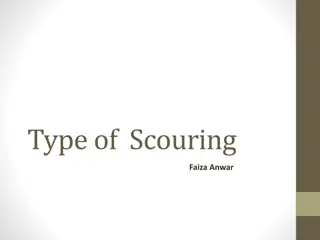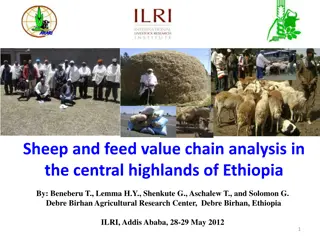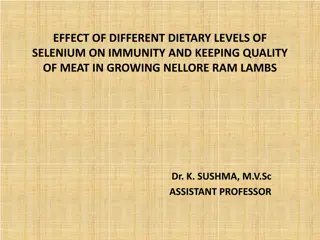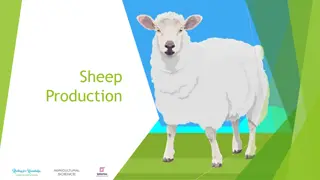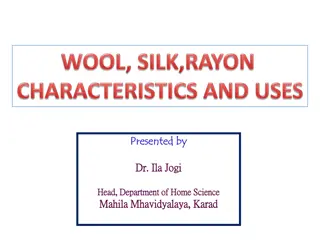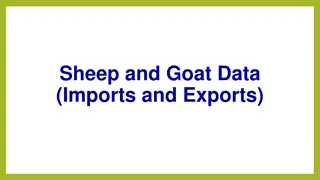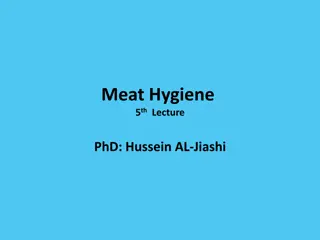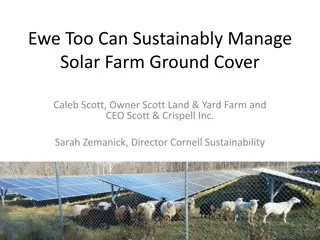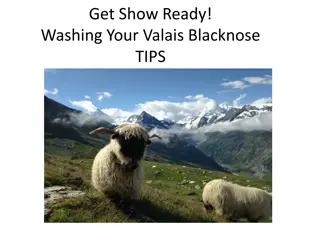Raising Wool Breed Sheep: Why It Matters in Showing and Selling
Discover the significance of raising wool breed sheep, including the benefits of high-quality wool, the importance of wool quality in show placements, and how judges evaluate fleece quality in competitions. Explore the competitive edge, ease of handling, and less competition compared to meat breeds. Learn about showcasing wool quality in sheep showing and why it's essential for success.
Download Presentation

Please find below an Image/Link to download the presentation.
The content on the website is provided AS IS for your information and personal use only. It may not be sold, licensed, or shared on other websites without obtaining consent from the author. Download presentation by click this link. If you encounter any issues during the download, it is possible that the publisher has removed the file from their server.
E N D
Presentation Transcript
WHY RAISE WOOL BREED SHEEP? DAVE COOK
DONT LIKE TO WASH SHEEP EASIER TO FIT THAN MEAT BREEDS LESS COMPETITION THAN MEAT BREEDS JUST LOOKING FOR ANOTHER BREED TO SHOW & SELL
HIGH QUALITY WOOL Important reason for raising a wool breed
WHAT ABOUT THE JUDGES!! EGO TRIP EXHIBITORS TRUST PLACING LINE HOW DOES IT LOOK? WOOL QUALITY IMPORTANT IN PLACING WOOL BREEDS
Judges need to be prepared for the possibility that spectators will not be able to visually follow when judging fitted wool breeds
Judges can pick pattern and fit jobs, while pandering to the crowd, or use the opportunity to promote traits that have utility and value.
Judges of the wool breeds must use wool quality as a major factor in their placings!
THRESHOLDS AND MARGINAL DIFFERENCES
A judge can only judge the sheep that enter the ring. Hopefully there are several individuals in the class that reach a threshold for minimum fleece quality.
The higher placing animals should be a combination of good conformation & soundness plus high fleece quality
Classes with deep quality allow the judge to evaluate marginal difference when making their final placings!
A class winner should not sacrifice wool quality even if those bystanders around the ring can not see the differences.
WHAT IS GOOD WOOL? as with all things context is critical
LIVE Show vs FLEECE Show In a fleece show as a judge you are looking at the end product and determining its quality for a specific use. In a live show a judge is evaluating an animal s genetic ability to produce the end product by observing its phenotype! It is not possible to evaluate certain traits on the hoof e.g. staple length.
COMMERICAL FLEECE SHOW SIZE matters total clean (Clean Wool Fiber Present), fineness, & staple length
HAND SPINNING SHOW Quality Traits Rule how clean, how soft, how white, & how much luster
BREED CLASS FLEECE SHOW Trueness to breed type should be considered Does the wool meet the breed scorecard? Are judges obligated to follow scorecard?
Score Card For Wool Judging (Commercial Classes) Estimated Clean Wool Content (yield and shrinkage) 35 Points High fleece yield with low shrink. Light-colored yolk as free from adhering sand, dirt and vegetable matter as possible. Fiber should be strong throughout and free from breaks. Location of tender points very important. A distinct middle break goes to bottom of class. When testing strength pay particular attention to staple ends. In the US many flocks shear prior to lambing. This often results in a weaning stress break near the tip which increases combing and carding shrink. If tip break, estimate carding shrink and cut place significantly lower accordingly.
Length 25 Points Should be combing or staple length for the grade: Fine- 64, 70, 80 spin count, < 22.04 micron 3 in.; 1 2 blood- 60, 62 spin count, 22.05 to 22.94 micron 3-1 2 in. 3/8 blood - 56, 58 spin count, 24.95 to 27.84 micron 3-3 4 in. 1 4 blood- 50, 54 spin count, 30.99 to 27.85 micron 4 in. low 1 4 blood 46, 48 spin count, 34.39 to 31 micron 4-1 4 in. Common and Braid, 44, 46, 36 and coarser spin count, 34.40 and coarser micron, 4-1 2 in. Lengths more than 1 2 inch greater than this are of no additional value except increasing the yield. Uniform staple length very important. Severely discount varied staple lengths including from sheep fitted prior to shearing.
Uniformity 20 points Internal uniformity particularly important. Internal variation cannot be skirted and ends up in Top. Must have a good Coefficient of Variation. Side to Britch variation of secondary importance. Cut heavily for hairy britch. Cut sharply for belly wool. Crimp, Character, and Style 10 Points Well defined crimp from butt to tip. Both Frequency and amplitude of crimp important. Crimp related to Curvature, Resistance to Compression, and Bulk. Higher variation in uniformity associated with poorer crimp definition. Purity, Color, and Luster 10 points Free from hair, kemp, gare, black or brown fibers. Cut heavily for black or brown fibers and coarse hairy britch. White to cream, bright color most desirable. Should be free from stains and with an even distribution of scourable yolk. Poly twine contamination goes to bottom of class.
Score Card For Wool Judging. (Hand Spinning) Different emphasis is placed on some characteristics when judging wool for commercial use compared to fleeces for handcraft use. Handcraft people tend to work with single fleeces, or often parts of a fleece, and adjust aspects of their procedures to the small amount of wool they are processing. Shrinkage 30 Points While shrink is merely a component of yield commercially, it is primary for Spinners. Spinners care about cleanliness more than yield. Focus on the amount of total clean wool after shrink in the Commercial application shifts to the amount of shrink (waste) for Spinners. Extremely low levels of Vegetable Matter, dirt, wax, and suint (sweat) most important. The fleece must be well skirted. Fleece must be very clean. It is very hard to adequately wash dirty hand spinning fleeces and contaminated higher shrink fleeces cannot be spun in the grease if desired. Sheep often covered year around. More clean wool (yield) is obviously better than less clean wool, but a lot of dirty wool is of no value to the spinner/fiber artist.
Handle 20 Points Fleece must have a soft handle and is a primary selection criteria for spinners. No one wants to work with wool that is harsh to the hand. Handle involves several factors: Fiber Diameter, Comfort factor- fibers < 30 micron, Coefficient of Variation (primary to secondary follicle ratio), individual fiber rigidity/compression, and scale structure (both prominence of cuticle step height and their frequency- For example, high luster Romney wool often has a soft handle relative to its fiber diameter because of the low frequency and prominence of its scale structure.) Crimp, Lock formation, and Style 20 Points Uniform crimp from butt to tip both in terms of amplitude and frequency. Again, indicative of better CV. Shows more uniformity of fiber diameter along length of fiber in the staple. Less likely to have nutritionally derived tender spots. Better crimp indicates better aligned follicles which transposes to easier carding with less entanglement and less subsequent fiber loss. Dense well defined lock bundle structure with little cross fibering (easier to work with in non-mechanized systems). Better crimp adds to elasticity and draping qualities.
Uniformity 10 Points Uniformity of staple length and internal uniformity (CV) still important, but uniformity of grade less important since a whole fleece could be used for several different projects. Soundness and Staple 10 points Must have staple length and soundness (lack of tenderness) commensurate to handcraft requirement. Color and Luster 10 points White wool with high luster for grade is preferred. Dyes more vibrantly and produces more striking end products. With Natural Colored Hand Spinning fleeces >35% non white fiber. Although some colors more marketable than others, color is not a placing criteria.
JUDGING LIVE ANIMALS Know the Scorecard. How many points are on wool quality? Range of 35 to 60 points. What are the acceptable grade ranges? What traits can you judge? Clean yield is out. Staple length is out. We don t have mandated shearing dates like some Australian and New Zealand shows. So commercially the two most important traits are off the table. Density is a component of yield although it tends to be inversely related to the other component of yield-staple length. Density remains important as it give some indication of yield. Density also important to prevent dirt and VM penetration on non covered fleeces.
UNIFORMITY Uniformity. Top to bottom. Belly wool should be a death sentence. GO LOW should be an embarrassment to only check fleeces from middle of the body and above. Can t bend over or what? Belly wool does not grow staple, has harsher handle and is coarser than its crimp grading otherwise suggests, does not yield, is less dense feeling when its higher grease is factored out, thus being a negative indicators of the most important wool characteristics which are otherwise unknown when judging on the hoof. So, Belly wool loses points in the top three traits from our commercial scorecard. It is easily seen by over-elasticity, higher grease content, cross fibering, and poor lock line differentiation. Tips are noiled, pilled or matted. Interestingly people talk of carding belly wool out to disguise it in the fitting process, while actually making the problem more prominent. Great fleece sheep grow quality wool even on the belly.
Internal- Coefficient of Variation. Internal uniformity critical for high quality Top. Primary follicles produce longer coarser fiber and medullated fibers. Medullated fibers are therefore harsher to the touch. They also do not take dye. In unfitted fleece, primary follicle fiber is easily visualized as a halo effect or lamb coat effect, which is why fitting is not allowed in some New Zealand shows. Fleece tip can be viewed under stereo microscope to if see trimming or singeing has disguised lack of internal uniformity. Uniformity. Side to Britch. Fleece should be uniform from shoulder to side to britch.
Environmental factors Environmental factors can impact fleece quality in live shows. In a wool show they are irrelevant since you are judging an end product, but since in a live show you are trying the access the animal s genetic ability to produce the produce, it is useful to know how environment can effect a fleece. Feed. The nutritional plane can change mean fiber diameter 3 microns, or approximately 2 spinning counts. Feed changes also show up along the individual fibers and is a source of tenderness. Humidity and heat. High heat and humidity environments can significantly impact color and grease content. If a sheep with a belly wool problem is coming off a Wyoming bench at 6000 ft it will look markedly better than it does after spending a year in Ohio. Although color and grease are effected by these factors, they are still effected more by genetics. A sheep with more secondary follicles will be whiter since only primary follicles have sweat glands.
IN CLOSING always remember that nobody s eyes are calibrated in microns. That is why there is objective testing. Make your best effort to judge wool well while knowing you may be wrong.


